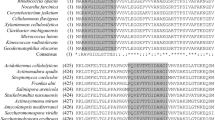Abstract
Taxonomic markers for differentiation of the anamorph genera Aureobasidium, Hormonema and Kabatiella were developed using PCR-ribotyping with the primers 5.8S-R and LR7 for amplification and the restriction enzymes Alul, DdeI, Hhal, MspI and RsaI for digestion. Aureobasidium and Hormonema are optimally differentiated with MspI; DdeI is particularly useful to distinguish aureobasidium, Kabatiella and Selenophoma. Relationships of the anamorph genera Aureobasidium, Hormoneng and Kabatiella with the teleomorph genera Pringsheimia and Dothiora are discussed.
Similar content being viewed by others
References
Aa HA van der (1975) The perfect state of Sarcophoma miribeli. Persoonia 8: 283–289
Butin H (1964) Über zwei Nebenfruchtformen von Sydowia polyspora (Bref. et v. Tav.) Müller. Sydowia 17: 114–118
Crang RE & Pechak DG (1977) Aureobasidium pullulans: fine structure and development. J. Coatings Technol. 50: 36–42
Dennis C & Buhagiar RWM (1973) Comparative study of Aureobasidium pullulans, A: prunorum sp. nov. and Trichosporon pullulans. Trans. Br. Mycol. Soc. 60: 567–575
Durrell LW (1968) Studies of Aureobasidium pullulans (De Bary) Arnaud. Mycopath. Mycol. Appl. 35: 113–120
Felsenstein J (1990) PHYLIP manual, version 3.3. University Herbarium, University of California, Berkeley, California
Froidevaux L (1972) Contribution à l'étude des Dothioracées (Ascomycètes). Nova Hedwigia 23: 679–734
Hermanides-Nijhof EN (1977) Aureobasidium and allied genera. Stud. Mycol. 15: 141–177
Hoog GS de, Gerrits van den Ende AHG, Uijthof JMJ & Untereiner WA (1995) Nutritional physiology of type isolates of currently accepted species of Exophiala and Phaeococcomyces. Antonie van Leeuwenhoek: 68: 43–49
Hoog GS de & Yurlova NA (1994) Conidiogenesis, nutritional physiology and taxonomy of Aureobasidium and Hormonema. Antonie van Leeuwenhoek 65: 41–54
McElroy D, Moran P, Bermingham E & Kornfield I (1991) The Restriction Enzyme Analysis Package, version 4.0 Orono, Maine
Nei M & Li WH (1979) Mathematical model for studying genetic variation in terms of restriction endonucleases. Proc. Natl. Acad. Sci. USA 76: 5269–5273
Pande I & Ghate J (1985) Aureobasidium indicum. Biovigyanam. 11: 113
Ramaley AW (1992) Tectacervulus mahoniae, Kabatina mahoniae, and Selenophoma mahoniae, three new fungi on Mahonia repens. Mycotaxon 43: 437–452
Richiteanu A & Teodorescu G (1989) A new Aureobasidium, pathogen of the cultivated blueberries (Vaccinium spp.) in Romania. Revue Roum. Biol. 34: 93–102
Robak H (1952) Dothichiza pityophila (Cda.) Petr., the pycnidial stage of a mycelium of the type Pullularia pullulans (de B.) Berkhout. Sydowia 6: 361–362
Sanderson FR (1965) Description and epidemiology of Guignardia fulvida sp. nov., the ascogenous state of Aureobasidium pullulans var. lini (Lafferty) Cooke. N.Z.J. Agric. Res. 8: 131–141
Simon L (1984) Etude ultrastructurale des différentes regions de I'hyphe chez Aureobasidium pullulans (De Bary) Arnaud. Cryptog. Mycol. 5: 323–344
Sivanesan A (1984) The bitunicate Ascomycetes. J. Cramer, Vaduz, 701 pp
Spatafora JW, Mitchell TG & Vilgalys R (1993) Analysis of genes coding for small-subunit rRNA sequences in studying phylogenetics of dematiaceous fungal pathogens. J. Clin. Microbiol. 33: 1322–1326
Takeo K & Hoog GS de (1991) Karyology and hyphal characters as taxonomic criteria in ascomycetous black yeasts and related fungi. Antonie van Leeuwenhoek 60: 35–42
Uijthof JMJ & Hoog GS de (1995) PCR-ribotyping of type isolates of currently accepted Exophiala and Phaeococcomyces species. Antonie van Leeuwenhoek 68: 35–42
Vilgalys R & Hester M (1990) Rapid genetic identification and mapping of enzymatically amplified ribosomal DNA from several Cryptococcus species. J. Bacteriol. 172: 4238–4246
White TJ, Bruns T, Lee S & Taylor J (1990) Amplification and direct sequencing of fungal ribosomal RNA genes for phylogenetics. In: Innis MA, Gelfand DH, Sninsky JJ & White TJ (Eds) PCR Protocols: a Guide to Methods and Applications. (pp. 315–322) Academic Press, San Diego
Yurlova NA & Sinitskaya IA (1993) The cell wall composition and structure of the fungi of genus Aureobasidium. Mikol. Fitopatol. 27: 65–73
Yurlova NA, Mokrousov IV & Hoog GS de (1995) Intraspecific variability and exopolysaccharide production in Aureobasidium pullulans. Antonie van Leeuwenhoek 68: 57–63
Author information
Authors and Affiliations
Rights and permissions
About this article
Cite this article
Yurlova, N.A., Uijthof, J.M.J. & de Hoog, G.S. Distinction of species in Aureobasidium and related genera by PCR-ribotyping. Antonie van Leeuwenhoek 69, 323–329 (1996). https://doi.org/10.1007/BF00399621
Received:
Accepted:
Issue Date:
DOI: https://doi.org/10.1007/BF00399621




